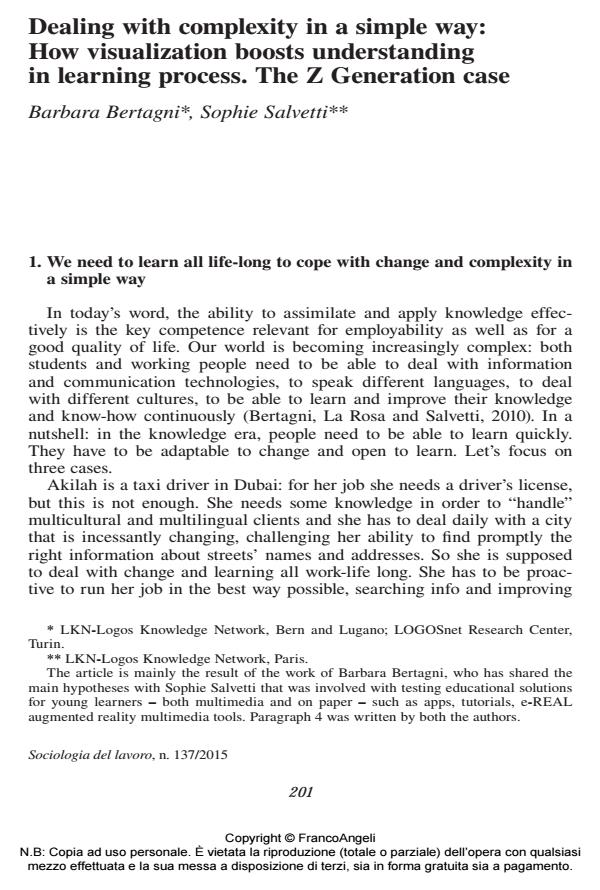Dealing with complexity in a simple way: How visualization boosts understanding in learning process. The Z Generation case
Titolo Rivista SOCIOLOGIA DEL LAVORO
Autori/Curatori Barbara Bertagni
Anno di pubblicazione 2015 Fascicolo 2015/137
Lingua Inglese Numero pagine 15 P. 201-2015 Dimensione file 189 KB
DOI 10.3280/SL2015-137012
Il DOI è il codice a barre della proprietà intellettuale: per saperne di più
clicca qui
Qui sotto puoi vedere in anteprima la prima pagina di questo articolo.
Se questo articolo ti interessa, lo puoi acquistare (e scaricare in formato pdf) seguendo le facili indicazioni per acquistare il download credit. Acquista Download Credits per scaricare questo Articolo in formato PDF

FrancoAngeli è membro della Publishers International Linking Association, Inc (PILA)associazione indipendente e non profit per facilitare (attraverso i servizi tecnologici implementati da CrossRef.org) l’accesso degli studiosi ai contenuti digitali nelle pubblicazioni professionali e scientifiche
In today’s word, the ability to assimilate and apply knowledge effectively is a key competence very relevant for employability. In the knowledge age, people need to be able to learn quickly and incessantly. As educators, we have to rethink tools, methodologies, setting and pace in education in order to really help people improving their competencies all life-long. Interactive edugraphics combining knowledge visualizations, illustrations, text, and images together are an interesting and engaging way to effectively facilitate learning people from different fields, cultures, cognitive styles, level of knowledge. Visualization is a powerful approach both for general education and for training. Especially when we face the education of the young people growing up in the digital word, visualization is strategic - as highlighted by the case of a Zed Generation girl, Sophie (that also co-authored a paragraph of the present article). The educational approach for the 21st century needs to be more learner-centered, interactive, customizable, blended - combining activities technology-based and experiences in a team, like in the flipped classroom. In such a scenario, augmented reality tools are becoming very relevant - like in the e-REAL labs that are briefly introduced.
Nel mondo odierno l’abilità di acquisire ed applicare il sapere in modo efficace è una competenza chiave molto rilevante per l’accesso al mondo del lavoro. Nella società della conoscenza, le persone devono essere capaci di imparare rapidamente ed costantemente. In quanto educatori, dobbiamo ripensare gli strumenti, le metodologie, il setting ed il ritmo in ambito educativo per riuscire davvero ad aiutare le persone a potenziare le loro competenze lungo tutto l’arco della loro vita. Gli edugraphics interattivi - che combinano visualizzazione della conoscenza, illustrazioni, testo ed immagini - sono un modo interessante e coinvolgente per facilitare il processo di apprendimento di persone provenienti da diversi ambiti, culture, con differenti stili cognitivi e diversi livelli di competenza. La visualizzazione è un approccio straordinario sia per l’educazione generale che per la formazione professionale. La visualizzazione è uno strumento strategico, soprattutto nei processi educativi indirizzati alle giovani generazioni cresciute nel mondo digitale - come evidenziato dal caso di Sophie, ragazza della generazione Z (che è anche coautrice di un paragrafo del presente articolo). L’approccio educativo È opportuno che nel XXI secolo l’approccio educativo sia centrato sulla persona che apprende, interattivo, personalizzato - integrando attività basate sulle tecnologie ad esperienze in gruppo, come nel caso dell’insegnamento capovolto. In questo scenario, gli strumenti legati alla realtà aumentata sono sempre più importanti - come nel caso dei laboratori e-REAL che sono brevemente presentati.
Parole chiave:Generazione Z, e-REAL, edugraphic, visualizzazione della conoscenza, insegnamento capovolto, apprendimento visuale
- The Social Genres of Comics Valentina Cappi, Emanuele Leonardi, pp.187 (ISBN:978-3-031-99184-4)
Barbara Bertagni, Dealing with complexity in a simple way: How visualization boosts understanding in learning process. The Z Generation case in "SOCIOLOGIA DEL LAVORO " 137/2015, pp 201-2015, DOI: 10.3280/SL2015-137012